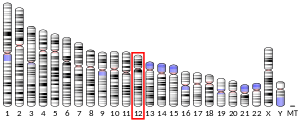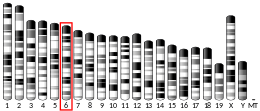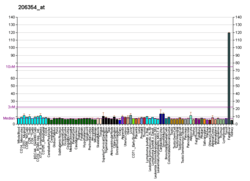Solute carrier organic anion transporter family member 1B3
Solute carrier organic anion transporter family member 1B3 (SLCO1B3) also known as organic anion-transporting polypeptide 1B3 (OATP1B3) is a protein that in humans is encoded by the SLCO1B3 gene.[5]
OATP1B3 is a 12-transmembrane domain influx transporter. Normally expressed in the liver, the transporter functions to uptake large, non-polar drugs and hormones from the portal vein.
Clinical significance
OATP1B3 has also been identified as a transporter aberrantly expressed in prostate cancer and implicated in prostate cancer progression.[6] Increasing mRNA expression of OATP1B3 was also correlated to prostate cancer Gleason score.[7]
In addition, lower expression of OATP1B3 mRNA was also detected in testicular cancer.[7]
Substrates
Small molecules that are transported by SLCO1B3 include:[8]
- Amanitin
- Atrasentan
- Bilirubin
- Bosentan
- BQ-123
- Bromsulphthalein (BSP)
- CDCA-NBD
- Cholate (CA)
- Cholecystokinin octapeptide (CCK-8)
- Dehydroepiandroserone-3-sulfate (DHEAS)
- Deltorphin II
- Demethylphalloin
- Digoxin
- Docetaxel
- [D-penicillamine2,5]enkephalin (DPDPE)
- Enalapril
- Estradiol-17β-glucuronide 5–25
- Estrone-3-sulfate
- Fexofenadine
- Fluvastatin
- Fluo-3
- Glutathione (GSH)
- Glycocholate (GCA)
- Glycoursodeoxycholate (GUDCA)
- Irinotecan
- Leukotriene C4 (LTC4)
- Methotrexate
- Microcystin
- Monoglyucuronosyl
- Olmesartan
- Ouabain
- Paclitaxel
- Phalloidin
- Pitavastatin
- Rifampicin
- Ro 48-5033 (Bosentan metabolite)
- Rosuvastatin
- SN-38
- Taurocholate (TCA)
- Taurochenodeoxycholate (TCDCA)
- Taurodeoxycholate (TDCA)
- Tauroursodeoxycholate (TUDCA)
- Telmisartan
- Thyroxine (T4)
- TR-14035
- Triiodothyronine (T3)
- Valsartan
See also
References
- GRCh38: Ensembl release 89: ENSG00000111700 - Ensembl, May 2017
- GRCm38: Ensembl release 89: ENSMUSG00000030236 - Ensembl, May 2017
- "Human PubMed Reference:". National Center for Biotechnology Information, U.S. National Library of Medicine.
- "Mouse PubMed Reference:". National Center for Biotechnology Information, U.S. National Library of Medicine.
- "Entrez Gene: SLCO1B3 solute carrier organic anion transporter family, member 1B3".
- Hamada A, Sissung T, Price DK, Danesi R, Chau CH, Sharifi N, Venzon D, Maeda K, Nagao K, Sparreboom A, Mitsuya H, Dahut WL, Figg WD (June 2008). "Effect of SLCO1B3 haplotype on testosterone transport and clinical outcome in caucasian patients with androgen-independent prostatic cancer". Clin. Cancer Res. 14 (11): 3312–8. doi:10.1158/1078-0432.CCR-07-4118. PMC 2701141. PMID 18519758.
- Heather Pressler; Tristan M. Sissung; David Venzon; Douglas K. Price; William D. Figg (May 2011). "Expression of OATP Family Members in Hormone-Related Cancers: Potential Markers of Progression". Clin. Cancer Res. 6 (5): e20372. Bibcode:2011PLoSO...620372P. doi:10.1371/journal.pone.0020372. PMC 3098289. PMID 21625523.
- Hagenbuch B, Gui C (July 2008). "Xenobiotic transporters of the human organic anion transporting polypeptides (OATP) family". Xenobiotica. 38 (7–8): 778–801. doi:10.1080/00498250801986951. PMID 18668430.
Further reading
- König J, Cui Y, Nies AT, Keppler D (2000). "Localization and genomic organization of a new hepatocellular organic anion transporting polypeptide". J. Biol. Chem. 275 (30): 23161–8. doi:10.1074/jbc.M001448200. PMID 10779507.
- Abe T, Unno M, Onogawa T, et al. (2001). "LST-2, a human liver-specific organic anion transporter, determines methotrexate sensitivity in gastrointestinal cancers". Gastroenterology. 120 (7): 1689–99. doi:10.1053/gast.2001.24804. PMID 11375950.
- Ismair MG, Stieger B, Cattori V, et al. (2001). "Hepatic uptake of cholecystokinin octapeptide by organic anion-transporting polypeptides OATP4 and OATP8 of rat and human liver" (PDF). Gastroenterology. 121 (5): 1185–90. doi:10.1053/gast.2001.28704. PMID 11677211.
- Jung D, Podvinec M, Meyer UA, et al. (2002). "Human organic anion transporting polypeptide 8 promoter is transactivated by the farnesoid X receptor/bile acid receptor". Gastroenterology. 122 (7): 1954–66. doi:10.1053/gast.2002.33583. PMID 12055601.
- Strausberg RL, Feingold EA, Grouse LH, et al. (2003). "Generation and initial analysis of more than 15,000 full-length human and mouse cDNA sequences". Proc. Natl. Acad. Sci. U.S.A. 99 (26): 16899–903. Bibcode:2002PNAS...9916899M. doi:10.1073/pnas.242603899. PMC 139241. PMID 12477932.
- Cui Y, König J, Nies AT, et al. (2003). "Detection of the human organic anion transporters SLC21A6 (OATP2) and SLC21A8 (OATP8) in liver and hepatocellular carcinoma". Lab. Invest. 83 (4): 527–38. doi:10.1097/01.lab.0000065015.02412.48. PMID 12695556.
- Ota T, Suzuki Y, Nishikawa T, et al. (2004). "Complete sequencing and characterization of 21,243 full-length human cDNAs". Nat. Genet. 36 (1): 40–5. doi:10.1038/ng1285. PMID 14702039.
- Vavricka SR, Jung D, Fried M, et al. (2004). "The human organic anion transporting polypeptide 8 (SLCO1B3) gene is transcriptionally repressed by hepatocyte nuclear factor 3beta in hepatocellular carcinoma". J. Hepatol. 40 (2): 212–8. doi:10.1016/j.jhep.2003.10.008. PMID 14739090.
- Hirano M, Maeda K, Shitara Y, Sugiyama Y (2004). "Contribution of OATP2 (OATP1B1) and OATP8 (OATP1B3) to the hepatic uptake of pitavastatin in humans". J. Pharmacol. Exp. Ther. 311 (1): 139–46. doi:10.1124/jpet.104.068056. PMID 15159445.
- Letschert K, Keppler D, König J (2005). "Mutations in the SLCO1B3 gene affecting the substrate specificity of the hepatocellular uptake transporter OATP1B3 (OATP8)". Pharmacogenetics. 14 (7): 441–52. doi:10.1097/01.fpc.0000114744.08559.92. PMID 15226676.
- Yamaguchi H, Okada M, Akitaya S, et al. (2006). "Transport of fluorescent chenodeoxycholic acid via the human organic anion transporters OATP1B1 and OATP1B3" (PDF). J. Lipid Res. 47 (6): 1196–202. doi:10.1194/jlr.M500532-JLR200. PMID 16534140.
- Ohtsuka H, Abe T, Onogawa T, et al. (2006). "Farnesoid X receptor, hepatocyte nuclear factors 1alpha and 3beta are essential for transcriptional activation of the liver-specific organic anion transporter-2 gene". J. Gastroenterol. 41 (4): 369–77. doi:10.1007/s00535-006-1784-3. PMID 16741617.
- Briz O, Romero MR, Martinez-Becerra P, et al. (2006). "OATP8/1B3-mediated cotransport of bile acids and glutathione: an export pathway for organic anions from hepatocytes?". J. Biol. Chem. 281 (41): 30326–35. doi:10.1074/jbc.M602048200. PMID 16877380.
- Mahagita C, Grassl SM, Piyachaturawat P, Ballatori N (2007). "Human organic anion transporter 1B1 and 1B3 function as bidirectional carriers and do not mediate GSH-bile acid cotransport". Am. J. Physiol. Gastrointest. Liver Physiol. 293 (1): G271–8. doi:10.1152/ajpgi.00075.2007. PMID 17412826.
- Treiber A, Schneiter R, Häusler S, Stieger B (2007). "Bosentan is a substrate of human OATP1B1 and OATP1B3: inhibition of hepatic uptake as the common mechanism of its interactions with cyclosporin A, rifampicin, and sildenafil". Drug Metab. Dispos. 35 (8): 1400–7. doi:10.1124/dmd.106.013615. PMID 17496208.
- Muto M, Onogawa T, Suzuki T, et al. (2007). "Human liver-specific organic anion transporter-2 is a potent prognostic factor for human breast carcinoma". Cancer Sci. 98 (10): 1570–6. doi:10.1111/j.1349-7006.2007.00570.x. PMID 17760952.




